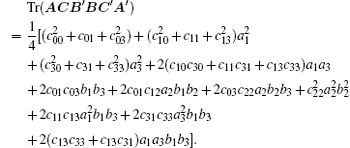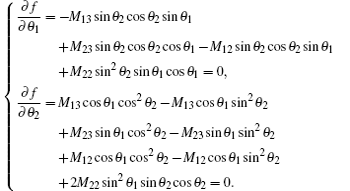† Corresponding author. E-mail:
Project supported by the National Natural Science Foundation of China (Grant Nos. 11275131, 11305105, and 11271138) and Simons Foundation (Grant No. 198129).
We consider the geometric global quantum discord (GGQD) of two-qubit systems. By analyzing the symmetry of geometric global quantum discord we give an approach for deriving analytical formulae of the extremum problem which lies at the core of computing the GGQD for arbitrary two-qubit states. Furthermore, formulae of GGQD of arbitrary two-qubit states and some concrete examples are presented.
The quantum correlations[1] between the subsystems 𝔄 and 𝔅 of a bipartite system play a significant role in many information processing tasks[2] and applictions.[3–5] It can be classified according to the probability distributions of the measurement outcomes from measuring the subsystems 𝔄 and 𝔅. For any quantum entangled states, the probability distributions of the measurement outcomes from measuring the subsystem 𝔄 will depend on the probability distributions of the measurement outcomes from measuring the subsystem 𝔅. Nevertheless, it is still possible that the correlations between the measurement outcomes from measuring the subsystem 𝔄 and measuring the subsystem 𝔅 can be described by classical probability distributions. A quantum state is pronounced to hold a local hidden variable model (LHV) if all the measurement results can be modeled as a classical random distribution over a probability space. The states admitting LHV models do not violate any Bell inequalities, while the states that do not admit any LHV models violate at least one Bell inequality.[6–8]
For separable states, the probability distributions of measurement outcomes from measuring the subsystem 𝔄 are independent of the probability distributions of the measurement outcomes from measuring subsystem 𝔅. However, these separable states may be further classified as classically correlated states and quantum correlated ones, depending on the possibility of memorizing all the mutual information by evaluating one of the subsystems. Such property is characterized by so-called quantum discord.[9–12] It has been shown that the quantum discord is required for some information processing like assisted optimal state discrimination.[13,14]
In recent years more relevant measures such as geometric quantum discord[15–17] (GQD) have been suggested. It makes use of different quantities and offers analytical solutions in some conditions generally.[18–21] However, in the original definitions both the quantum discord and the geometric quantum discord are not symmetric with respect to the subsystems. For a symmetric extension of the quantum discord the global quantum discord has been presented in Ref. [22]. Furthermore, a geometric quantum discord for multipartite states, called geometric global quantum discord (GGQD), has been proposed in Ref. [23]. Nevertheless, similar to the original discord, it is extremely difficult to calculate the GGQD for generally given quantum states. In this paper, we study the GGQD for arbitrary two-qubit systems, and derive explicit expressions.
The paper is organized as follows. In Section 2, we review GQD and GGQD. We derive an analytical formula of GGQD for arbitrary two-qubit states. In Section 3, as examples we work out the GGQD for X-states. Conclusions and discussion are given in Section 4.
For a bipartite state ρ𝔄𝔅 in a composite system 𝔄𝔅, the total correlation between 𝔄 and 𝔅 is measured by the quantum mutual information




The quantities I(ρ𝔄𝔅) and J(ρ𝔄𝔅) are equal in the classical case. However they are different in the quantum case. The difference defined by D(ρ𝔄𝔅) = I(ρ𝔄𝔅) – J(ρ𝔄𝔅) is called the quantum discord of the ρ𝔄𝔅. As the measurement is single side measurement of bipartite system, the global quantum discord D(ρ𝔄1𝔄2⋯𝔄N) for an arbitrary multipartite state ρ𝔄1𝔄2⋯𝔄N is defined by





Following the concept of global quantum discord, the geometric global quantum discord (GGQD) is defined by





Now consider the GGQD of two-qubit states. For bipartite qubit states ρ𝔄𝔅, equation (






Note that under local unitary transformations, any two-qubit state can be written as









By taking a coordinate transformation b1 = cosθ1 sin θ2, b2 = sinθ1 sinθ2 and b3 = cosθ2, we have






As we know, it is too difficult to calculate the exact value of geometric global quantum discord.[23] Nevertheless, our method above can be used to calculate it and some detailed examples will be given in the next section.
We now apply our approach to calculate some two-qubit states. Let us first consider X-states,[24] which, under local unitary transformations, have the form of









Now, we would like to show a more detailed example. Let us consider











We have calculated the geometric global quantum discord for arbitrary two-qubit states. Although the geometric global quantum discord is controlled by many parameters of the quantum states, we analyze the symmetry of geometric global quantum discord and simplify the problem. Then we adopt our method to demonstrate how the parameter of two-qubit states influences the outcome. Furthermore, continuing our idea we work out the extremum problem which lies at the core of calculating the geometric global quantum discord for arbitrary two-qubit states and obtain the accurate solution of the geometric global quantum discord for arbitrary two-qubit states. Some detailed examples are also presented.
| 1 | |
| 2 | |
| 3 | |
| 4 | |
| 5 | |
| 6 | |
| 7 | |
| 8 | |
| 9 | |
| 10 | |
| 11 | |
| 12 | |
| 13 | |
| 14 | |
| 15 | |
| 16 | |
| 17 | |
| 18 | |
| 19 | |
| 20 | |
| 21 | |
| 22 | |
| 23 | |
| 24 |


